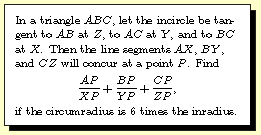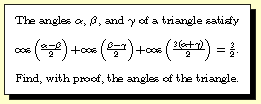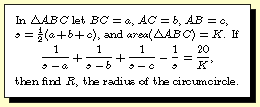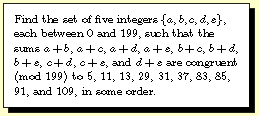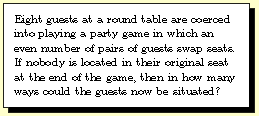... .....
|
Past Corner Problems: 2000 |
|
............
![]()
|
The Problems: |
The Solvers: |
|
Question 2000-1 |
...... |
|
Question 2000-2 |
...... |
|
Question 2000-3 |
...... |
|
Question 2000-4 |
..... |
|
Question 2000-5 |
...... |
|
Question 2000-6 |
...... |
|
Question 2000-7 |
...... |
|
Question 2000-8 |
...... |
ANSWERS TO 2000
PROBLEMS
Question 2000-1
-- The given sum reduces to 4R/r-2, where R and r are the
radii of the circumcircle and incircle, respectively.
Therefore the answer is 22.
Question 2000-2 -- One
conjectures that the cosine of each angle must equal 1/2,
leading to the unique solution A=20, B=140, and C=20
degrees.
Question 2000-3 -- If we
locate point P on side AB of the triangle with PA=3 and
PB=4, then arrange for PC to pass through the center of the
circumcircle, a limiting value of R=3.7 can be achieved.
Question 2000-4 -- First
show that the left hand side can be reduced to abc/K^2,
where K stands for the area of the triangle. It then follows
that R=5.
Question 2000-5 -- The
given statement implies that the triangle must be a right
triangle. (Why?) It is now easy to argue that the maximal
area is 25.
Question 2000-6 -- An
isosceles triangle with sides of length 25, 25, and 30
produces an area of 300, the minimum possible.
Question 2000-7 -- The
cute answer to this question is {101, 103, 109, 127,
181}.
Question 2000-8 -- This
question was a difficult exercise in the principle of
inclusion-exclusion. There are 7413 even permutations of
eight objects with no fixed points.
......

